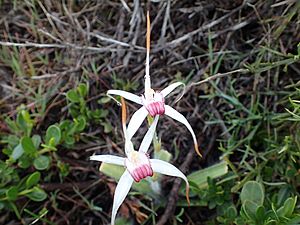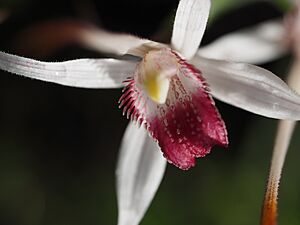Exotic spider orchid facts for kids
Quick facts for kids Exotic spider orchid |
|
|---|---|
 |
|
| Caladenia nivalis in the Leeuwin-Naturaliste National Park | |
| Scientific classification | |
| Genus: |
Caladenia
|
| Species: |
nivalis
|
| Synonyms | |
|
|
The exotic spider orchid, also called the crystalline spider orchid, is a special type of orchid. Its scientific name is Caladenia nivalis. You can only find this beautiful flower in the south-west part of Western Australia. It's easy to spot because of its bright white, pale pink, and red flowers. It mostly grows in and around the Leeuwin-Naturaliste National Park.
Contents
What Does the Exotic Spider Orchid Look Like?
The Caladenia nivalis is a plant that grows from the ground. It's a perennial plant, meaning it lives for more than two years. It's also deciduous, so its leaves fall off at certain times. This plant has an underground tuber (like a small potato) and one upright, hairy leaf. This leaf is about 100 to 180 millimeters (4–7 inches) long and 4 to 15 millimeters (0.2–0.6 inches) wide.
The orchid can have up to three bright white flowers. Sometimes, these flowers are pale pink. Each flower is about 60 to 80 millimeters (2–3 inches) long and 50 to 80 millimeters (2–3 inches) wide. They grow on a stem that is about 120 to 200 millimeters (5–8 inches) tall.
Flower Parts
The orchid's sepals (leaf-like parts that protect the flower bud) have thick, brown, club-shaped tips.
- The top sepal stands upright. It is about 35 to 55 millimeters (1.4–2.2 inches) long and 3 to 4 millimeters (0.1–0.2 inches) wide.
- The side sepals are also 35 to 55 millimeters (1.4–2.2 inches) long and 5 to 7 millimeters (0.2–0.3 inches) wide. They spread out wide, but their tips point downwards.
- The petals are about 30 to 50 millimeters (1.2–2.0 inches) long and 4 to 5 millimeters (0.16–0.20 inches) wide. They are arranged like the side sepals.
The labellum (which is the orchid's special lip) is about 18 to 25 millimeters (0.7–1.0 inch) long and 10 to 12 millimeters (0.4–0.5 inches) wide. It is white near its base and then turns bright red. The tip of the labellum curls underneath. The sides of the labellum have small teeth, up to 2.5 millimeters (0.1 inch) long. There are also four or more rows of red bumps called calli along the center. These calli are up to 1.5 millimeters (0.06 inches) long. This orchid usually flowers from late August to October.
How Did It Get Its Name?
The Caladenia nivalis was first officially described in 2001. This was done by two scientists, Stephen Hopper and Andrew Phillip Brown. Their description was published in a scientific journal called Nuytsia.
The second part of its scientific name, nivalis, comes from a Latin word. It means "snowy" or "of snow." This name was chosen because of the orchid's bright white flowers, which can look like snow.
Where Does This Orchid Live?
The exotic spider orchid grows in a specific area of Western Australia. You can find it between Cape Naturaliste and Moses Rock. This area is part of the Jarrah Forest and Warren biogeographic regions. It likes to grow in places with peppermint trees, in coastal heath (areas with small shrubs), and in cracks in granite rocks.
Is This Orchid Safe?
The Western Australian Government's Department of Parks and Wildlife has looked at the Caladenia nivalis. They have classified it as "not threatened." This means that, for now, there are enough of these orchids, and they are not in danger of disappearing.


